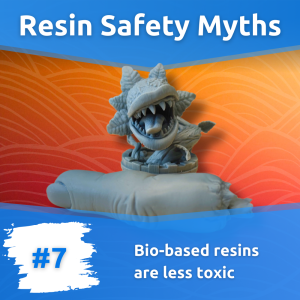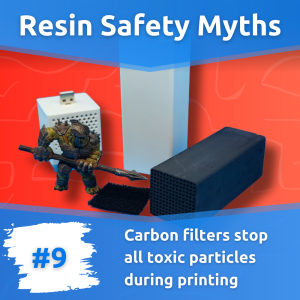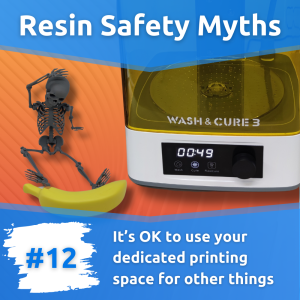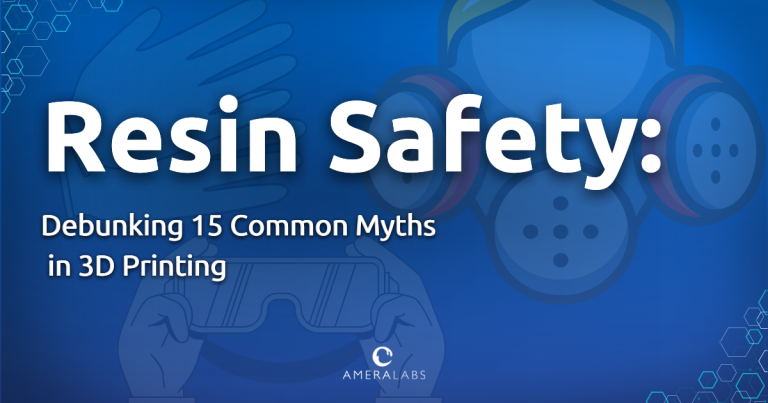Introduction to Resin Safety Myths
Resin-based technology has revolutionized 3D printing, enabling intricate designs with unparalleled precision. However, safety must not be overlooked amidst the excitement of creating stunning resin prints.
Resin printing involves handling chemicals that, if mishandled, can pose serious health risks. Unfortunately, many myths and misconceptions surrounding resin safety persist, potentially leading to unsafe practices and endangering users.
Resin-based 3D printing offers remarkable design capabilities, but safety must always come first. Our guide delves into fifteen common resin safety myths, equipping you with practical insights to navigate resin printing securely. From comprehending resin limitations to prioritizing ventilation and protective gear, we ensure your printing environment is safe. Join us in confidently embracing resin printing for a secure and rewarding journey.
Regardless of whether you’re a beginner or an expert in resin 3D printing, prioritizing your health and taking necessary precautions should never be underestimated.
#1 Water-washable resin is a safe alternative for 3D printing

Water-washable resin has garnered attention for its purported ease of use and cleanup. However, it’s vital to address this resin safety myth that it inherently provides a safer option for 3D printing. While it may simplify certain aspects of the printing process, it does not eliminate the need for stringent safety measures.
Understanding the chemical composition and potential hazards of any resin material is paramount. This information is typically outlined in the safety data sheet (SDS) provided by the manufacturer. Despite its washability, water-washable resin still contains chemicals that can pose health risks if not handled properly.
Proper protective equipment, including gloves, goggles, and protective clothing, should always be worn when handling resin materials. This helps minimize the risk of skin irritation and other adverse effects associated with direct contact.
Responsible disposal of resin waste is also crucial to prevent environmental harm. Pouring water mixed with resin down the sink can contaminate waterways and harm aquatic ecosystems. Instead, it’s important to follow proper disposal methods, such as solidifying and disposing of cured resin according to local regulations.
While water-washable resin may offer convenience in cleanup, it does not negate the need for rigorous safety protocols. By prioritizing safety and adhering to proper handling practices, we can ensure a safer and more responsible approach to resin-based 3D printing.
#2 Not smelly resin means it’s less toxic

The notion that less smelly resins equate to reduced toxicity is a common misconception in the 3D printing community. This belief stems from the assumption that the presence of a strong odor indicates the presence of harmful chemicals, while the absence of smell implies safety. However, the reality is far more nuanced.
Resin fumes can indeed be elusive, often escaping detection by the human nose. The lack of a distinct odor does not necessarily mean that the fumes are non-toxic. In fact, some resin formulations may emit harmful fumes without any noticeable smell, making odor an unreliable indicator of toxicity.
To safeguard against potential health risks associated with resin fumes, it’s essential to prioritize safety measures. This includes wearing proper personal protective equipment (PPE), such as respirators and nitrile gloves, to minimize exposure. Additionally, ensuring proper ventilation in the workspace is crucial for dispersing fumes and reducing inhalation risks.
Furthermore, familiarizing oneself with the safety data sheet (SDS) provided by the resin manufacturer is imperative. The SDS has vital information about the chemical composition of the resin, potential hazards, and recommended safety precautions. Handling resin prints with care and following proper disposal procedures are essential steps in minimizing health and environmental risks.
In conclusion, the absence of a strong odor does not indicate safety when it comes to resin toxicity. By understanding the limitations of odor detection and prioritizing comprehensive safety measures, we can ensure a safer and more responsible approach to resin-based 3D printing.
#3 Wearing nitrile gloves is optional

The belief that wearing nitrile gloves is optional when handling resin is a dangerous misconception that can have dire consequences for personal safety. Nitrile gloves serve as a crucial barrier between the skin and resin materials, protecting against potential allergic reactions, irritation, and chemical burns.
Nitrile gloves should be considered an essential part of personal protective equipment (PPE) for anyone involved in resin printing activities. Choosing the right fit and ensuring proper glove usage is paramount to maintaining a safe working environment.
Resin, if not handled properly, can pose significant health risks. Skin contact with uncured resin can lead to adverse reactions, including dermatitis and chemical burns. By wearing nitrile gloves, users create an additional layer of protection against direct contact with resin materials, reducing the risk of skin-related issues.
By prioritizing safety and adhering to proper handling practices, users can protect their hands and ensure a safer resin printing experience.
#4 Uncured resin prints are safe to touch

The misconception that uncured prints are safe to touch is a dangerous belief that can lead to serious health risks for individuals involved in resin printing activities. Uncured prints contain residual uncured resin, which can pose significant hazards if proper precautions are not taken.
Handling uncured prints without proper protection is akin to playing with fire. Direct skin contact with uncured resin can lead to skin irritation, sensitization, and other adverse health effects. Therefore, it’s crucial to treat uncured prints with the utmost care and prioritize personal safety.
Delving into the safety data sheet (SDS) provided by the resin manufacturer is essential for understanding the potential hazards associated with uncured prints. This information helps users identify the proper handling procedures and safety precautions necessary to minimize risks.
When handling uncured prints, wearing appropriate personal protective equipment (PPE), such as nitrile gloves, is imperative. Gloves act as a barrier between the skin and the resin, reducing the risk of direct contact and potential adverse reactions.
Furthermore, disposing of uncured prints responsibly is essential to prevent environmental contamination and minimize health risks. Following proper disposal procedures outlined in the SDS ensures that uncured prints are handled and disposed of in a safe and environmentally friendly manner.
By prioritizing safety, adhering to proper handling practices, and disposing of uncured prints responsibly, users can protect their health and minimize risks associated with resin printing.
#5 Quickly running to my resin print room without PPE is safe

The belief that quickly running to the print room without personal protective equipment (PPE) is safe is a dangerous misconception that can have long-term implications for personal health and well-being. While individuals may feel immune to immediate effects, such as irritation or discomfort, cumulative exposure to resin materials can lead to severe allergies over time.
Resin particles can gradually accumulate in the body through repeated exposure, increasing the risk of developing allergic reactions and sensitivities. Even if individuals show no symptoms initially, the gradual buildup of resin in the body can trigger allergic responses in the future.
To mitigate the risk of developing allergies and sensitivities, it’s essential to take precautions seriously and prioritize personal protective measures. Wearing appropriate PPE, such as gloves, goggles, and a respirator, is crucial for minimizing exposure to resin fumes and particles.
By acknowledging the potential long-term consequences of resin exposure and prioritizing personal protective measures, individuals can safeguard their health and well-being in the print room.
#6 Cured resin prints are food-safe

The belief that cured resin prints are safe for food contact is a myth that requires clarification to ensure consumer safety. While it may be tempting to assume that post-curing resin prints makes them suitable for food-related applications, this is not the case.
Post-curing resin prints may improve their mechanical properties, but it does not address potential health concerns associated with their use for food contact. The surfaces of cured resin prints can be uneven, providing an ideal environment for bacteria, mold, and other harmful pathogens to thrive.
Even if post-cured, resin materials may contain toxic substances that can leach into food or beverages, posing health risks if ingested. Therefore, it is crucial to refrain from using 3D printed resin cups or utensils for food contact unless they are explicitly certified as food safe.
Prioritizing safety and refraining from using resin prints for food-related applications are essential steps to protect consumer health and well-being.
#7 Bio-based resins are less toxic

The misconception that bio-based resins are inherently less toxic is a myth that requires clarification to ensure a proper understanding of resin safety. While bio-based resins may offer environmental benefits, it is essential to recognize that their toxicity levels can vary depending on their chemical composition.
Bio-based resins undergo chemical modifications by chemists to achieve desired properties, potentially altering their chemical composition. As a result, assumptions about their safety based solely on their “green” label can be misleading.
To safeguard against potential health risks associated with bio-based resins, it is crucial to prioritize safety measures. This includes reading the Material Safety Data Sheet (MSDS) provided by the resin manufacturer to understand the specific hazards associated with the resin.
Proper disposal of bio-based resins is also essential to prevent environmental contamination and minimize health risks. Following the recommended disposal procedures outlined in the MSDS ensures that bio-based resins are handled and disposed of responsibly.
By prioritizing safety, reading MSDS, and adopting proper disposal practices, users can protect themselves and the environment while working with bio-based resins.
#8 Post-cured resin parts are safe for long-term skin contact

While post-curing resin prints can improve their mechanical properties, it doesn’t guarantee safety for prolonged skin exposure.
Residues or uncured components in post-cured parts can still cause skin irritation or allergic reactions with prolonged contact. It’s crucial to handle post-cured parts with caution and prioritize safety.
To minimize skin-related risks, users should adhere to safety measures and consult resin manufacturers for guidance. Understanding the hazards linked to post-cured parts and taking necessary precautions are vital for ensuring user safety.
Prioritizing safety and adopting necessary precautions can safeguard users from potential health hazards related to resin printing.
#9 Carbon filters stop all toxic particles during printing

The belief that carbon filters provide total protection from toxic particles during resin printing is a misconception. While effective against some VOCs and odors, they may not capture all hazardous emissions.
Carbon filters can become saturated and lose effectiveness over time, especially in high-volume printing settings. Therefore, users should not rely solely on carbon filters but instead implement comprehensive ventilation systems to ensure proper airflow and removal of airborne contaminants.
In addition to ventilation, wearing appropriate personal protective equipment (PPE), such as gloves, goggles, and a respirator, is essential to minimize the risk of inhalation and skin contact with resin materials.
By prioritizing safety measures like ventilation and PPE usage, users can establish a safer working environment.
#10 Face mask is sufficient protection for resin printing

While face masks offer some protection against airborne particles, they’re insufficient for filtering volatile organic compounds (VOCs) emitted during resin printing.
To ensure safety, users should switch to Organic Vapor Filter respirators or half masks. These specialized respirators effectively filter harmful fumes and particles, providing enhanced protection against inhalation hazards linked with resin printing.
In addition to respiratory protection, wearing appropriate personal protective equipment (PPE) like gloves and goggles is crucial. This minimizes the risk of skin contact and eye irritation.
By upgrading to the right respirator and embracing comprehensive safety measures, users establish a safer work environment for resin printing activities.
#11 Printer hood safely contains all the resin fumes

While printer hoods are designed to contain fumes, they do not necessarily remove particles from the air.
Printer hoods create an enclosed space around the printer, trapping resin fumes within. However, opening the hood can release trapped particles back into the air, potentially exposing users to hazardous emissions.
To minimize exposure to resin fumes, it is essential to complement printer hoods with proper ventilation and safety measures. This includes ensuring adequate airflow within the printing environment and implementing additional ventilation systems if necessary.
By prioritizing safety measures and minimizing exposure to resin fumes, users can create a safer working environment.
#12 It’s OK to use your dedicated printing space for other things

While it may seem convenient, mixing spaces can lead to increased exposure to resin fumes and accidental contamination.
Resin fumes emitted during printing can linger, posing inhalation hazards and staining surfaces with resin residue. Using the space for unrelated activities raises the risk of spills or contact with resin materials, resulting in contamination and potential health risks.
To prioritize safety and maintain an organized workspace, designate your printing area exclusively for printing tasks. Avoid placing your resin 3D printer in the kitchen, bathroom, bedroom, living room, or other living spaces.
By keeping your printing space dedicated solely to printing activities, you can create a safer and more efficient working environment.
#13 Washing with water is enough after skin contact with resin

While water can remove some resin residue, it may not effectively eliminate all traces of the material.
After any skin contact with resin, it’s advisable to thoroughly cleanse the affected area with a mild soap and water combination. Do not use IPA! This helps remove resin residue and reduces the risk of irritation or allergic reactions.
Additionally, wearing gloves and other protective gear can significantly minimize direct exposure to resin, thus reducing the need for extensive skin cleaning procedures. Prioritizing the use of proper protective gear is crucial to prevent skin contact with resin.
#14 Tools used for printing and post-processing can be used elsewhere

The misconception that 3D printing tools can be used interchangeably elsewhere ignores potential health hazards. Residue on tools from resin printing and post-processing can lead to skin irritation or respiratory issues.
Even small amounts of residue pose risks upon contact or inhalation. Prioritizing safety means using 3D printing tools only for their intended purposes.
To minimize exposure, adopt proper cleaning and storage practices. Thoroughly clean tools with solvents and store them separately to prevent cross-contamination.
#15 You don’t need to replace safety gloves often

The misconception about safety gloves persists but jeopardizes user safety in resin printing. Despite their essential protection, gloves degrade over time, reducing effectiveness.
Continued use of deteriorating gloves increases the risk of resin exposure. Tears or holes in gloves can lead to skin contact, causing irritation or allergic reactions.
To ensure optimal protection, replace gloves regularly as recommended. Inspect them before each use to ensure they’re in good condition.
Conclusion: Prioritizing Safety in Resin Printing
Safety is paramount in resin printing. This article debunks fifteen common myths to empower users and promote safer practices.
Each myth addressed highlights key considerations for safeguarding against potential health risks. Resin printing offers creative possibilities but requires caution due to potential hazards.
By dispelling misconceptions and emphasizing safety measures, we create a safer working environment. Safety is a collective responsibility, and sharing insights ensures everyone can enjoy resin printing safely.
Let’s prioritize safety, support one another, and foster a culture of responsibility. Together, we can make resin printing safer and more enjoyable.

